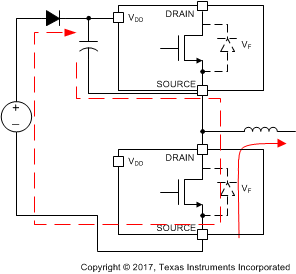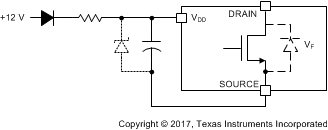ZHCSIP2E April 2016 – October 2018 LMG3410R070 , LMG3411R070
PRODUCTION DATA.
- 1 特性
- 2 应用
- 3 说明
- 4 修订历史记录
- 5 Pin Configuration and Functions
- 6 Specifications
- 7 Parameter Measurement Information
- 8 Detailed Description
- 9 Application and Implementation
- 10Power Supply Recommendations
- 11Layout
- 12器件和文档支持
- 13机械、封装和可订购信息
10.2.2 Managing the Bootstrap Voltage
In a synchronous buck, totem-pole PFC, or other converter where the low-side switch occasionally operates in third-quadrant mode, it is important to consider the bootstrap supply. During the dead time, the bootstrap supply charges through a path that includes the third-quadrant voltage drop of the low-side LMG341xR070. This third-quadrant drop can be large, which may over-charge the bootstrap supply in certain conditions. The VDD supply of LMG341xR070 must not exceed 18 V in bootstrap operation.
 Figure 17. Charging Path for Bootstrap Diode
Figure 17. Charging Path for Bootstrap Diode The recommended bootstrap supply connection includes a bootstrap diode and a series resistor with an optional zener as shown in Figure 18. The series resistor limits the charging current at startup and when the low-side device is operating in third-quadrant mode. This resistor must be chosen to allow sufficient current to power the LMG341xR070 at the desired operating frequency. At 100 kHz operation, a value of approximately 5.1 ohms is recommended. At higher frequencies, this resistor value should be reduced or the resistor omitted entirely to ensure sufficient supply current.
 Figure 18. Suggested Bootstrap Regulation Circuit
Figure 18. Suggested Bootstrap Regulation Circuit Using a series resistor with the bootstrap supply will create a charging time constant in conjunction with the bypass capacitance on the order of a microsecond. When the dead time, or third-quadrant conduction time, is much lower than this time constant, the bootstrap voltage will be well-controlled and the optional zener clamp in Figure 18 will not be necessary. If a large deadtime is needed, a 14-V zener diode can be used in parallel with the VDD bypass capacitor to prevent damaging the high-side LMG341xR070.